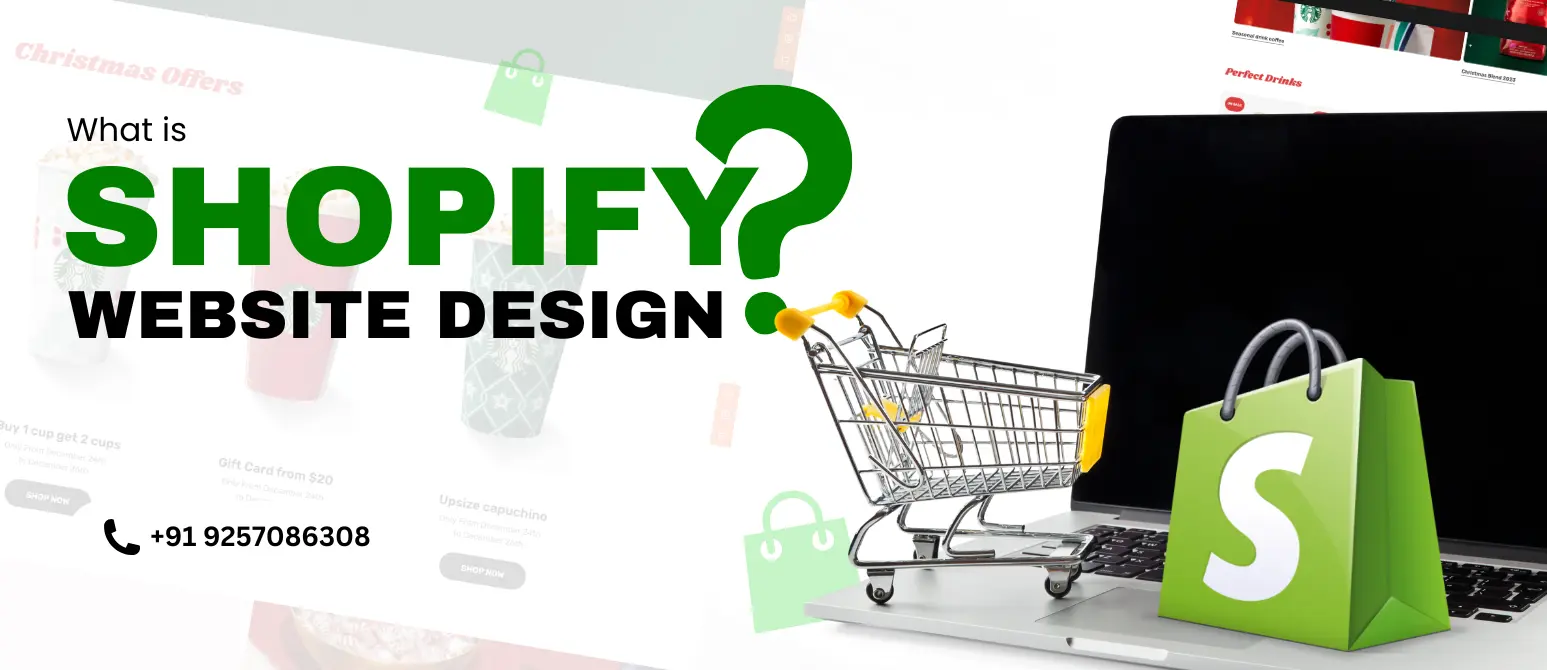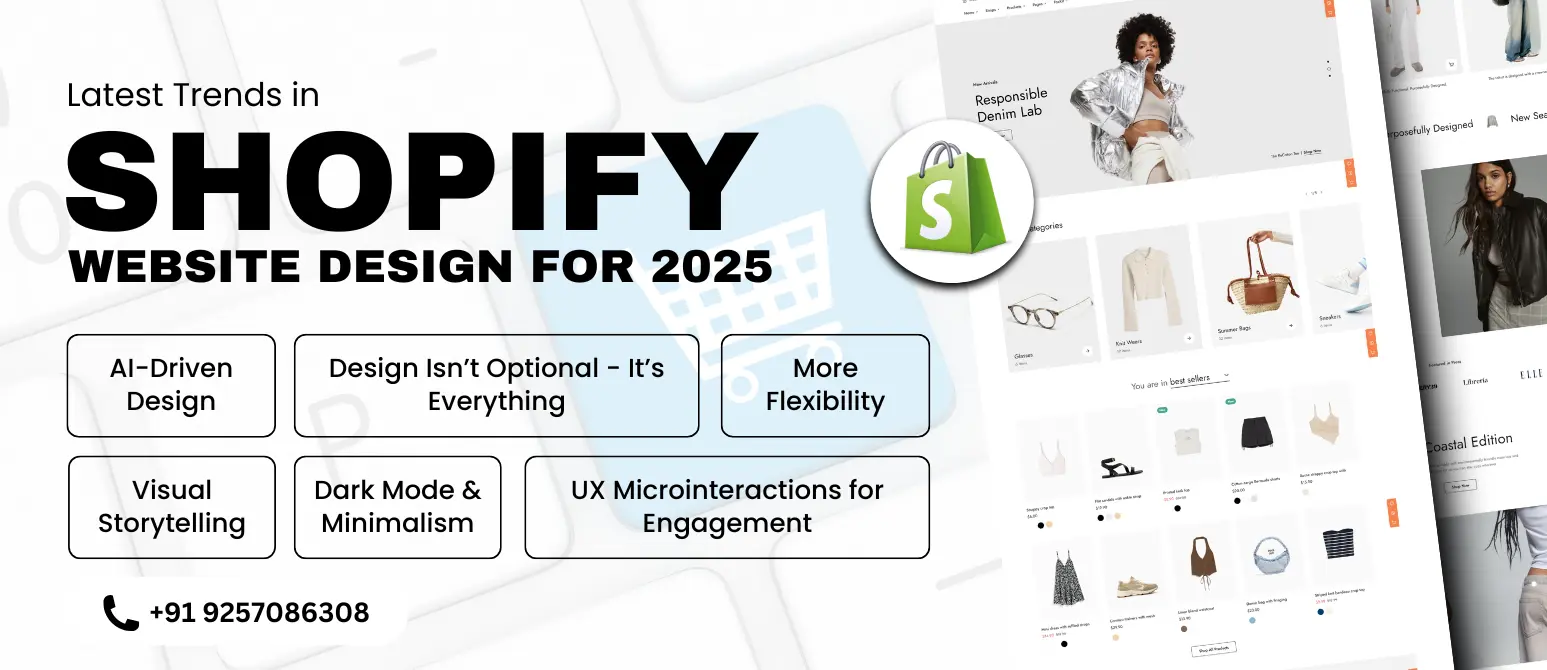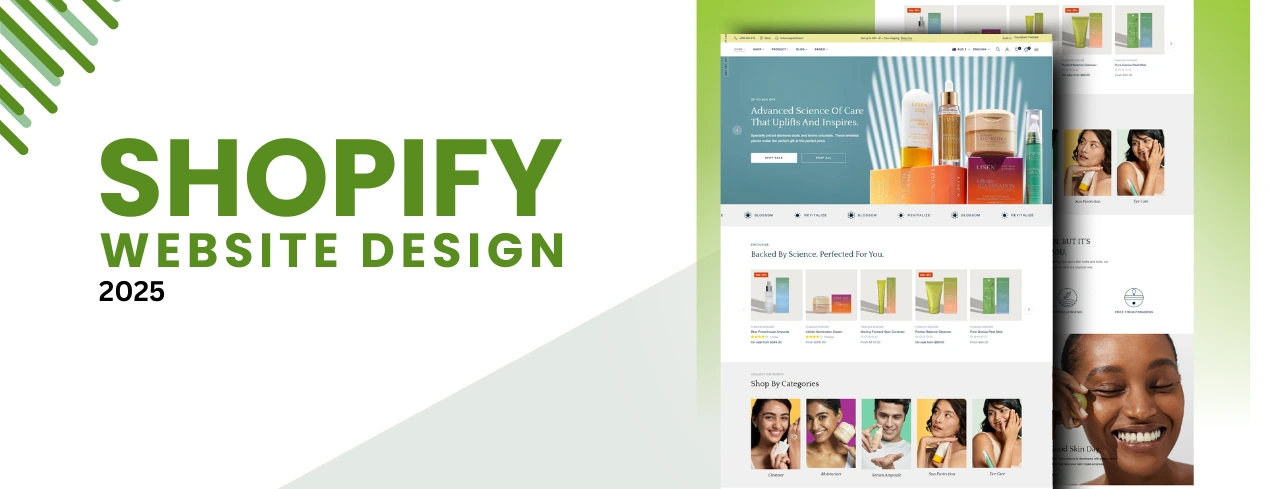The Shopify web design in 2025 is no longer a mere matter of making your web store look pretty or handsome; it is doing so in such a way that it helps to propel business success. Having more than 4.5 million active Shopify websites around the world, and the average visitor having a decision to stay or leave made in just 50 milliseconds, the design of your website has become your strongest sales weapon. An optimized design can make a huge difference in the bounce rates, duration, and conversions, whereas a crowded or outdated design might cost you thousands of dollars in lost business.
Shoppers have gone beyond merely enjoying beautiful fonts and high-resolution images, and now they want speed, mobile-first user experience, a user-friendly interface, and an experience that is as smooth as silk, even when it comes to cross-device optimization. Therefore, whether you are opening your first shop or engaging in a comprehensive redesign of your shop, it is crucial to know how Shopify web design in 2025 has evolved, so you can remain competitive.
Whether you are a founder who wants to expand their business and intend to scale, a brand marketer who wants to review your e-commerce strategy, or simply looking for how to find the best Shopify web design company to make your dream a reality, this will be your guide.
Table of Contents
What is Shopify Website Design?

Shopify web design is a methodical procedure of defining the visual layout, structure, and user experience (UX) of an online store built on the Shopify platform. In 2025, designing with colors, fonts, and choosing a pretty-looking theme will not be enough. One has to design for growth, usability, and conversions.
Shopify web design involves UI (User Interface) or UX (User Experience) on the most basic, core levels. UI addresses the appearance of your website- typography, visuals, spacing, and colors- whereas UX will establish how your customers navigate and shop, pointing to your shop interface. Combined, they determine the factors of customer retention, engagement, and whether they will click the “Buy Now” button or bounce.
When Shopify web design is well executed, it will:
- Establishes visual brand identity
- Improves site speed and mobile responsiveness
- Makes navigation through the home page, collections, and product pages easier
- Improves SEO with neat designs and structure of content
- Inspires trust using elements such as reviews, CTAs, and a safe checkout flow
Design can no longer be an afterthought for brands in the current competitive environment. The conversion rate optimization (CRO), customer retention, and repeat purchases are directly connected to Shopify e-commerce website design.
You can build a Shopify site anew or optimize an old one, but there are two fundamental directions for designing a Shopify website:
- Theme-based Shopify design- Faster, cheaper, and highly suitable for scaling young brands
- Custom Shopify design solutions- Designed for custom scaling, high-end functionality, and full-brand control
Mobile-first optimization, accessibility, personalization, and micro-interactions are also taken into consideration by modern Shopify web design since they are vital to the overall performance of the store. And that is where a professional Shopify web design company enters the picture. Not only do professional Shopify designers work on the appearance of your site, but they also create shops that convert, including constructing your homepage design to tailoring your product page experience.
The bottom line is that Shopify web design is no longer optional, but rather your digital storefront strategy. And as we are going to see next, its significance in 2025 is even higher.
Why is Shopify Website Design Important?
In a modern e-commerce-driven environment, a visually attractive store is a non-negotiable success factor. Millions of online stores are clamoring for the attention of every customer, and with it, Shopify website design becomes your most effective selling point. However, this is not just about the appearance of your store, but rather it is about functionality, experience, and conversion.
The goal of a well-designed Shopify store goes way beyond presenting products. It tells people where to go, gains their trust, and makes them act, and in 2025, it is the backbone of scalable growth.
Here’s why investing in Shopify web design is mission-critical:
First Impressions Decide Everything
Research indicates that users spend less than 0.5 seconds to make a judgment about your site. On a Shopify store, that initial impression might be the distinction between a bounce and a conversion. A good design generates instant trust; a bad design drives people away. An e-commerce business on a Shopify website cannot afford to compromise brand identity with user expectations at the first fold.
Design = Conversions
A great design is strategic persuasion. Simple CTAs, sticky navigation, mobile responsiveness, and fast loading speed are all parts of your design that directly affect the level of sales made by your store. Seamless layouts, low-redundancy checkout, and compelling page formatting of products can cause a surge in Shopify website sales with design alone.
Mobile-First Experience is Now Default
Shopify mobile optimization is necessary, considering that more than 72% of sales occur online on mobile. The prerequisite is a responsive, intuitive, and tap-friendly design. Shopify mobile responsive design tips help brands not to lose a significant part of the audience because of insufficient investments.
SEO, Speed & Structure are All Design-Driven
Technical performance is also improved by having a well-designed Shopify site. Hierarchies of pages, quick load speeds, image compression, and mobile optimization are all related to increased SEO rankings and improved user experience, which is a direct outcome of the well-planned Shopify UI/UX design.
It’s the Foundation of Brand Identity
Whether it be the fonts, iconography, animations, or the styling of the product page, all the visual means support your brand experience. The design of a Shopify website in 2025 has to declare faithfulness, power, and relatability, particularly in oversaturated industries. A personalized, uniform Shopify website design will make your brand less generic and more memorable.
Intending to open a new online shop or reinvent an old one, the design of your Shopify website will dictate how long visitors spend on it, whether they make a purchase, or never come back.
Latest Trends in Shopify Website Design for 2025

Now, along with the advanced development of e-commerce, the visual and functional language of online stores is also developing. Shopify web design in 2025 is not only a matter of an aesthetically designed interface or a mobile-friendly experience; it is also about immersive, intelligent, and frictionless experiences. User psychology, AI integrations, and the increasing desire for hyper-personalized shopping have become the trends in design.
In order not to become outdated, your Shopify store needs to adjust to the way users navigate, purchase, and make decisions. The following are the best Shopify web design trends that are influencing the future of digital stores:
Personalized Shopping with AI-Driven Design
The Shopify UI/UX design now integrates Artificial Intelligence without any complications. Using AI, Shopify stores can be made dynamic, adapting to each user depending on their actions, and then optimizing themselves accordingly.
It will also be a standard to have smart layouts that can be rearranged according to preference, previous searches, as well as the geolocation of the users in 2025. The AI widgets and tools are becoming more and more part of Shopify design companies as they seek to enable relevance and conversions.
Mobile-First Design Isn’t Optional – It’s Everything
Mobile-first is not a buzzword, but it is the backbone of design. As the mobile traffic sweeps through e-commerce, your Shopify site has to be comfortable and super-swift on smartphones.
Trends include:
- Thumb-friendly navigation
- Natural flow-based vertical content blocks
- Quick conversion sticky cart buttons
That is why Shopify mobile optimization will remain one of the major priorities in 2025.
Headless Commerce for More Flexibility
The separation of front-end and back-end is becoming increasingly popular in modern Shopify stores using the headless architecture. It enables a more expensive design flexibility, quicker page loading, and combinations with other platforms (e.g., AR/VR libraries, native apps). The concept of headless Shopify design allows businesses to scale, personalize, and localize, and not being put in a box by theme restrictions.
Visual Storytelling & Immersive Product Displays
In 2025, customers do not desire to go through generic product pages. They desire narratives of the brands, interactive galleries, and scroll-triggered animations.
The trendsetters are employing:
- Full-width hero videos
- Scroll-triggered parallax effects
- Lifestyle-driven imagery paired with shoppable elements
It is common now to associate Shopify e-commerce site design with the mixture of both commerce and content.
Dark Mode & Minimalism for Better UX
Pure, uncluttered design becomes victorious. To become more legible and precise, brands are using a minimalist design, light/dark mode switchers, and whitespace to improve the clarity and focus of the UI. Not only does this appear modern, but it also increases time on site and reduces cognitive overload. Minimal Shopify store design enhances perceived loading time and makes CTAs as well as product characteristics stand out.
UX Microinteractions for Engagement
These include unobtrusive interactions in design, such as hover animations, tap sounds, or cart fly-ins, providing personality to a store. These microinteractions can improve the user experience without cluttering the website and are quickly becoming a trademark of modern Shopify UI/UX designs.
Quick Summary: Trends to Embrace in 2025
- AI-powered personalization
- Vertical and mobile-first UX
- Headless Shopify design
- Visual brand storytelling
- Simplistic, dark mode themes
- Delightful microanimations
- Voice-ready search and navigation
Not only are these design trends, but they are also data-driven practices embraced by the most reputable Shopify web design firms in the world. By keeping up with such trends, you stay ahead of your competition.
Top 10 Shopify Website Design Tips to Grow in 2025
Shopify web design has come a long way in 2025, from being mere aesthetics to becoming a complete growth strategy. As consumer expectations grow, competition becomes tough, and technological advances are thinking tall, how your Shopify store looks is not the only place to start in store design. How it performs also matters.
So here are 10 guru tricks that will not only bring you more sales but also help you achieve better engagement and put your brand in a place where it will keep on generating sales:
Prioritize Mobile-First Shopify Design
In 2025, mobile commerce is taking the lead and contributing to more than 70% of Shopify sales across the world. Your Shopify store needs to be responsive in terms of resizing to fit on any screen and have thumb-friendly buttons and fast-loading content. Give precedence to vertical scrolling and low-friction tapping. It is not a design decision; being mobile-first is a profitability strategy.
Structure Your Homepage to Tell a Story
First impressions are made at your homepage. Employ a powerful hero banner, a bold headline, and a call-to-action, and then proceed to value propositions, trust badges, and highlighted collections. Rather than clutter, whitespaces and modular pieces of content should be used to orient users. The aim is to find a way of taking the customer step-by-step to the action.
Create Engaging Product Visuals
Quality images create a real-life impression of products. Include lifestyle photography, 360-degree views, video demonstrations, and even AR tries in some categories. Such visual signals can lower the returns, provide answers to the questions asked by the users, and make buyers feel confident. Imagery is always at the epicenter of the best storytelling, Shopify website design tips.
Simplify Navigation and On-Site Search
People will not scratch around to find products; they will bounce. Make your navigational architecture lean, user-friendly, and perceptible. Large inventories can be handled through mega menus, fast sorts by filtering, and predictive search by auto-completed keywords and categories. An excellent Shopify UI/UX design begins and ends with efficient and speedy customer positioning towards the desired destination.
Design for Speed and Performance
The best-designed site will do no good when it is slow. Enhance compression of images, avoid bloating of apps, and clean coding. Select lightweight themes that support Core Web Vitals to minimize bounce rates and increase search positioning. Speed not only constitutes an SEO factor; it is a multiplier in the conversion process.
Showcase Social Proof and Trust Elements
Instant credibility is created through user-generated content, real customer reviews, and media mentions. Put secure payment, return policies, and shipping timelines badges. This positioning places them close to CTAs or other product information sections that boost confidence at the critical stages when most decisions are made.
Craft Compelling CTAs and Microcopy
Each and every word matters. Instead of the impersonal Buy Now, you should apply a CTA such as “Get Yours Today” or “See It in Action”. Small pieces of instructional text (microcopy) in and around the checkout, shipping, or size information can decrease friction and ambiguity. Design functionality is augmented by a good copy.
Leverage Personalization at Every Step
Utilize apps or integrated apps that allow customizing product suggestions, home page banners, and email reminders based on lookup history or geography. Personalized experiences improve engagement and average order value. In 2025, Shopify web design services on the platform are becoming more and more integrated with the customization of AI.
Know When to Go Custom Over Themes
Themes are excellent when kicking off, but established companies should use Shopify’s custom design. A custom build will ensure that your brand identity is reflected, performance is optimized, and it allows you to come up with unique user flows. It is an investment that becomes cost-effective as traffic and complexity increase.
Test Everything and Iterate Continuously
Your initial design will not be the best. Split-test variations of your home page banners, different call to action locations, and the layout of products with tools such as VWO or Google Optimize. Data-driven iteration assists you in keeping up with your users and remaining ahead of the changing design trends and purchase patterns.
Best Shopify Website Design Examples: Top Performers in 2025
As far as Shopify web design in 2025 is concerned, real-life inspiration is the best blueprint. The best Shopify website designs in 2025 have radical branding, focus on the user interface, blistering speed, and out-of-the-box UX considerations. In the case of a D2C brand scoring conversions or a niche retailer with a narrative, every example below will introduce you to what good Shopify web design means in 2025. Let’s explore what makes these stores worth learning from.
1. Allbirds
Sustainable footwear brand Allbirds is a pioneer in minimalist Shopify website design and eco-conscious storytelling. Their home page consists of clean graphics, crisp call to action, and intuitive navigation, which makes it extremely easy to navigate and use when one visits it for the first time. Its typography and format are light and non-obtrusive, and all the attention is given to the natural beauty of their product. Sizing guidelines, material specifications, and social proof in the form of reviews are provided on product pages in a scanable manner. Allbirds demonstrates that trust-building design is easy when there is a consistent color scheme and earthy visuals.
Design Highlights:
- Sticky cart
- Clear returns Information
- Eco-first visual storytelling
Takeaway: Simplicity + strong brand voice = trust and conversions.
2. Olipop
A healthy alternative to soda, Olipop delivers a Shopify web design that is dynamic, colorful, and has a playful branding. The design of the store is based on animation and color blocking to maintain visual activity across the site as the user browses it. The inclusion of a personalized shopping experience known as their “Find Your Flavor Quiz” is designed to both personalize and create health-conscious callouts of benefits, such as low sugar and prebiotics. Each detail from the home page to the checkout page is deliberate. The mobile UX is identical to the desktop with its comfortable navigation and fast loading speeds on different devices.
Design Highlights:
- Individualized shopping process
- Exciting squeeze animations and micro interactions
- Sticky nav bar optimised for mobile
Takeaway: Shopify UI/UX designs do not have to be dull; they can also be entertaining and friendly.
3. Gymshark
Gymshark’s site is a demonstration of Shopify e-commerce web design on scale. It is the perfect hybrid of polished frontend with backend muscle, an excellent fit for high-volume retailers. The navigation menu sections involve gender filters, product types, and region filters- all appearing in a de-cluttered and mobile-friendly manner. To maximize their product page interactions, they provide model sizes, restock updates, and consumer-generated content. Boasting a lightning-fast performance and image consistency across all worldwide locations, Gymshark offers a superior e-commerce experience, which keeps customers returning to it.
Design Highlights:
- Regional content and currency
- Advanced filtering
- Clean product page with the utilization of dynamic image swapping
Takeaway: Shopify website design in 2025 should be universal enough to resonate in any part of the planet, but at the same time, remain clear.
4. The Sill
The Sill provides a calm approach to the plant shopping experience that allows customers to explore soft, lifestyle photography and informational UX. With a soothing interface, the selection process becomes easy with categories such as “Easy for Beginners” or “Pet-Friendly”. There is care information with product pages, customization of pots, and images depicting the plants in various environments. Their education and blog sections are seamlessly incorporated, which makes the brand an authority. Sill is demonstrating how niche brands can build emotional connections by careful design.
Design Highlights:
- Education-driven design
- Lifestyle images that can be purchased
- Sticky support and live chat
Takeaway: Content + commerce = a Shopify store that nurtures trust.
5. Pura
The Shopify online store of Pura has a sensational feel, which is luxurious and high-end. Their homepage is a combination of ambient videos, soft transitions, and atmospheric tones to resemble the experience of sniffing out a scent. It has mood-based categories, scent notes, and subscription options on each product page, so the right choice is not difficult to make. User-generated reviews and the contents of those influencers add more credibility. Their visual hierarchy makes the shopping experience sleek and, at the same time, easy to use, which suits the premium positioning of the products.
Design Highlights:
- Bundles and subscriptions
- UGC carousel
- Motion-based homepage modules
Takeaway: Sensory products can get a life through professional Shopify web design.
Wish you had a store like them?
Brands like these often rely on specialized Shopify web design companies to build experiences that not only look good but convert at scale. Agencies like DQOT Solutions specialize in crafting high-performance, mobile-first stores tailored to your industry and user needs, whether through custom builds or optimized theme modifications.
Why Choose DQOT Solutions for Shopify Website Design in 2025
With regards to Shopify web design, a suitable partner may mean the difference between a mediocre store and one that can generate consistent growth. With online competition becoming fierce in 2025, businesses should have a Shopify website that is not only beautiful but also converts, performs well, and scales.
And that is where DQOT Solutions comes in. Being one of the top Shopify website development companies in India and a reputable company around the world, DQOT Solutions focuses on creating visually-appealing, high-performance Shopify websites that enhance the progress of every brand in terms of their identity and growth goals in mind.
Full-Spectrum Shopify Website Design Services
New in-store or gearing up to scale to your next million, we can give you end-to-end Shopify web design services. Whether it is theme customization, UI/UX design, performance tuning, or custom application installations, our professionals apply both sensitivity to design and technical expertise.
We realize that each business is distinct. This is why we include in our design procedure a careful series of discovery calls, competitor research, and brand matching sessions – to make your Shopify shop feel like your own.
Why Brands Choose DQOT Solutions?
- Custom Shopify Design Solutions: We do not merely rework templates, but operate custom Shopify web design solutions on a blank canvas to reflect your brand voice, product approach, and customer experience.
- Mobile-Optimized Experiences: All the website designs created by us are mobile-first by default. Your mobile buyers will convert higher with faster load times, touch-friendly navigation, and simplified checkout flows.
- Growth-Driven UI/UX: We use behavioral insights, heatmap data, and A/B testing to design for conversion, and not mere aesthetics. Imagine better product discovery, smarter cart flows, and even bigger average order values.
- Post-Launch Support: From technical support to design extension, our Shopify website re-design services make sure that your shop keeps up with the trends and expectations of the customers.
- Transparent Pricing Packages: DQOT Solutions is transparent with its pricing, support, and delivery, whether it is a theme-based quick launch or a large-scale, custom Shopify web design.
What Clients Say
“DQOT Solutions understood our business goals first while re-designing our Shopity website. Within three months of the redesign, our bounce rate dropped by 22%, and conversions increased by 40%.”
– Ritika Shah, Co-founder, ModernLoom Clothing
Being a result-driven Shopify design agency, DQOT Solutions helps ambitious brands to be at the frontlines and not be followers. Our designs are tactical, expandable, and fit to grow with you.
Final Thoughts
Shopify web design in 2025 is not just a cosmetic upgrade; it is the pillar of your store’s success. A good design influences the emotions, beliefs, decisions, and purchase behaviors of your customers. It is what enables you to turn leisure browsers into regular customers. Instead of approaching design as a one-time deliverable, leading brands internalize it as a business tool: the problem solver, the action driver, the revenue scaler.
All successful Shopify stores in 2025 are strategized: driven by data and human behavior in real life, achieving a flawless customer experience on every screen. From mobile-optimized layouts to product discovery flows, it is the design that determines how and what your business is experienced as and remembered for.
What Strategic Shopify Design Looks Like in 2025:
- Clear Homepage Hierarchy: Deliver value first, minimize clutter, and create credibility through readable copies.
- Smart Navigation: Filters, mega menus, and predictive search that reduce the route to purchase.
- Performance-Optimized Pages: Quick load times, lazy loading images, and asset compression to reduce bounce rates.
- Conversion-Driven CTAs: The copy, positioning, and layout of the buttons are optimized for clicks.
- Mobile-First Experience: Adaptive layouts, tap-friendly interfaces, and checkout flows made for thumbs.
- Trust Builders: Consolidated reviews, secure badges, and real-time stock or delivery notifications.
- Consistent Brand Identity: Font, color, voice, and microcopy, which is unified and memorable.
An excellent Shopify web design is invisible. It operates within the periphery, controlling all the choices your customer makes. At DQOT Solutions, we assist you in designing stores that not only look good but also expand your business.
FAQs About Shopify Website Design 2025
The following section tries to address the top questions that business users ask with regard to Shopify web design, and hopefully, this guide will enable you to make more informed choices when setting up or upgrading your online store in 2025.
An effective Shopify web design in 2025 is mobile-first, conversion-oriented, and user-centered. It is a mix of a clean design, swift loading times, easily identifiable navigation, interesting representations of products, and efficient checkout processes. There is also robust branding, trust signals, and intelligent personalization to have more engagement and higher ROI.
The price of a Shopify site design in 2025 may range widely depending on how complex the needs of your business will be, as well as customizations and the chosen agency. The prices of theme-based design projects begin at $500 – $2,000, whereas fully custom Shopify website design solutions can cost anywhere between $3,000 – $15,000 and even more. We have flexible packages at DQOT Solutions, depending on your business stage and size.
Themes are suitable when there is some rush or a tight budget, particularly with startups. But with custom Shopify designs, you have complete control over branding, user experience, and performance. Custom design will be a more practical long-term investment when your store expands or your business has special requirements.
The first thing you should do is take a responsive theme or get an expert Shopify web development company that knows how to use a mobile-first design. Make load speed, thumb navigation, and minimal design a priority. Your buttons should also be large, your text readable, and your mobile user checkout efficient.
The major trends are AI-powered personalization, immersive video product pages, mobile-first layouts, headless commerce integration, minimal branding, and sustainability-oriented UX design. Having these trends in your design will keep it new and help increase engagement and durability.
Make your CTAs clear, simplify your menu, use trust indicators and badges, as well as visual clutter reduction. Intelligent design choices at the major customer touchpoints, namely, homepage, product pages, and checkout, bring quantifiable growth in sales.
DIY can work when you start a small shop and also have experience in designing. However, when you consider scaling seriously, it is best to hire a professional Shopify design agency like DQOT Solutions that can offer strategic design, performance optimization, and post-launch support, which will save time and ultimately produce better results.
A Shopify web design assists you in creating, designing, and developing your e-commerce business. They manage branding, structure of layouts, presentation of products, mobile optimizations, performance optimizations, and even marketing integrations. The right partner will make your store not just pretty but business-ready.






